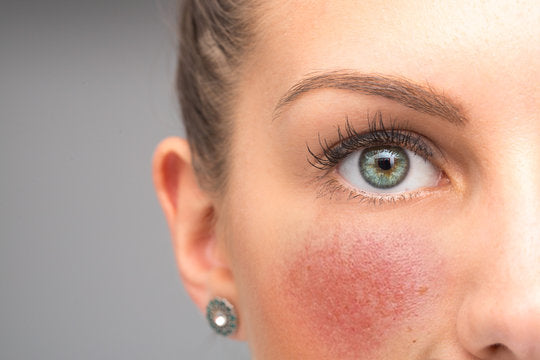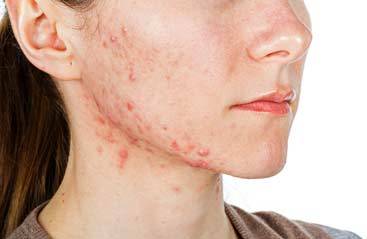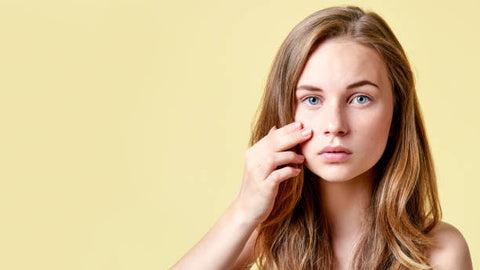Best Acne Face Wash for Rosacea

The skin is the body’s largest organ, and it is exposed to the sun and pollutants every day. These environmental stressors, together with the natural process of aging, hormonal changes, the use of make-up, or an unhealthy diet, can easily irritate and damage the skin.
Skin damage may come as wrinkles, uneven skin tone, or dry, flaky skin. For some, skin damage may appear as blackheads, pimples, or acne. If you notice redness or see tiny blisters and fine vascular lines on your facial skin, then you might be experiencing a skin condition known as rosacea.
What Is Rosacea?
Rosacea is an acne-like skin condition that can affect anyone, but it typically occurs in middle-aged women with light skin. Often, it is also mistaken for sunburn. The most common symptom of rosacea are tiny, red bumps that contain pus. Rosacea usually appears on the central region of the skin, mostly on the nose, cheeks, and forehead. There are four types of rosacea:
Type 1 Rosacea: Erythematotelangiectatic (ERT) Rosacea
ERT rosacea is the most common type of rosacea. It appears as erythema or skin redness, flushing, and small blood vessels or spider veins on the face. This type of rosacea often comes with a burning or stinging sensation.
Type 2 Rosacea: Inflammatory or Papulopustular Rosacea
Inflammatory rosacea, also called acne rosacea, may appear as papules or red bumps on the skin that do not contain any fluid. It may also appear as pustules or pus-filled bumps. Acne rosacea may also cause swelling, reddening, and/or burning and stinging of the skin.
While acne rosacea differs from acne vulgaris, it is sometimes difficult to distinguish one from the other. It is important to note that acne rosacea is not caused by the same factors as acne vulgaris. Acne vulgaris can appear anywhere on the face, neck, back, shoulders, or upper arms, while acne rosacea is centralized on the cheeks, nose, chin, and forehead. Acne is also common in teens, while most cases of acne rosacea will show by the age of 30 or older.
Type 3 Rosacea: Phymatous Rosacea
Phymatous Rosacea involves the thickening of facial skin. Thickening may appear in different parts of the face. It may cause the skin to swell, scar, or look bumpy or bulbous.
- Gnathophyma: thickening of the chin
- Metophyma: thickening of the forehead
- Rhinophyma: thickening of the nose; more common in men
Thick or bumpy skin may also appear in other areas, such as the ears or cheeks.
Type 4 Rosacea: Ocular Rosacea
Unlike other types of rosacea that manifest on the skin, Ocular rosacea affect the eyes. The symptoms include visibly red, dry or watery eyes. Some people may complain of having blurred vision. Ocular rosacea may also appear on the eyelids as cysts or inflammation called blepharitis.
Rosacea is more common in people with light or fair skin, but it may also affect people with dark skin. The following are symptoms of rosacea in medium or darker skin tones:
- Dryness and swollen skin
- Warm sensation
- Dark patches or a dusky brown skin discoloration
- Persistent acne-like breakouts
- Yellowish-brown bumps around the eyes and/or mouth
- Burning sensation when applying skincare products on the affected area
What Are the Common Triggers of Acne Rosacea?
Further study remains to be done on what exactly causes rosacea, but many scientists agree that a mix of genetic and environmental factors, as follows, can contribute to its development.
-
Genetic predisposition.A person who has a family history of rosacea is likely to inherit the genes for it.
-
Abundance of certain compounds in the blood. Cathelicidins, a type of protein that causes pimples, inflammatory bumps, skin flushing and visible blood vessels are present in elevated and irregular quantities in the blood of people with rosacea.
- Hypersensitivity to certain mites. Some people with rosacea have large numbers of Demodex mites, a particular type of skin mite that lives on the nose and cheeks.
- Helicobacter pylori. This bacterium is normally found in the gut and is known to raise the amount of gastrin, a digestive hormone that causes the skin to look red or flushed. However, not all people with rosacea have this bacterial infection.
Rosacea can make the skin extremely sensitive. Anything that causes rosacea to flare up is called a trigger. Rosacea triggers may vary from person to person. Some of the common triggers are:
Hot beverages
Consuming any type of hot beverage, including coffee, tea, or cider can cause rosacea breakouts. To prevent flare-ups, you can try drinking them in their cold or iced form. You can also let the beverage cool until it becomes warm or lukewarm.
Alcohol
Red wine and hard liquor are some of the biggest culprits when it comes to rosacea flare-ups. To reduce breakouts, try drinking white wine instead of red wine. Avoiding alcoholic beverages works best, but otherwise, you can also add lemonade or soda to wine, beer, or other alcoholic drinks to lessen the amount of alcohol.
Spicy foods
Spicy foods such as hot sauces, spices, and pepper heat the skin and lead to flare-ups. Try swapping out these foods with milder versions or other herbal substitutes to minimize the risk of breakouts.
Dairy
Dairy products such as yogurt, milk, and cheese trigger rosacea flare-ups. Limit consuming these types of foods if you suspect that dairy is a trigger for you.
Foods with histamine
Histamine makes the blood vessels dilate and potentially lead to flare-ups. Avoid foods rich in histamine such as tomatoes, nuts, legumes, chocolate, and citrus fruits.
Make-up
You may want to avoid using waterproof cosmetic products that don’t spread easily or require make-up remover. Instead, opt for a light, liquid-based foundation. You can also apply a mild, fragrance-free emollient before applying make-up.
Medicine
Some medicines can worsen rosacea, including those used for treating high blood pressure, glaucoma, migraine, and heart problems. If you feel that the medication you are taking triggers rosacea, consult your doctor for alternatives.
Wind and cold
Cold weather can cause windburn and may trigger a flare-up. You can avoid breakouts by protecting your face with a silk or acrylic scarf when you go outside. Also, limit your time outdoors and wear rosacea-friendly sunscreen every time you go out.
Sun exposure
A few minutes under the sun may lead to flushing or redness. If you are going outside, always wear gentle, fragrance-free sunscreen (SPF 30 or higher). Also, choose one that contains zinc oxide or titanium dioxide.
Exercise
Exercising increases the body’s temperature and can result in rosacea flare-ups. You can still perform your workout routine, but try lowering the intensity or exercising in a cool room or in water. You can also bring supplies that can cool you down, such as a towel dipped in cold water draped around your neck or a bottle of cold water.
Stress
Stress can also lead to potential breakouts. When you find yourself in a stressful situation, take a moment to breathe. You can also learn tai chi, meditate, or join a support group.
How Can You Reduce Rosacea Breakouts?
A good skincare routine can help put the brakes on rosacea flare-ups. When shopping for skincare and haircare products, look out for ingredients such as menthol, camphor, or sodium lauryl sulfate, which are rosacea triggers. Witch hazel, glycolic acid, hydroquinone, tretinoin, peppermint, and eucalyptus oil are also rosacea irritants.
What Ingredients to Look For in a Face Wash
If you’re searching for the best acne face wash or cleanser for rosacea, choose one that contains the following ingredients:
Hyaluronic Acid
Hyaluronic acid helps restore the skin’s natural moisture, which can be beneficial for people with rosacea.
Zinc Oxide
Zinc oxide has anti-bacterial, anti-microbial, and anti-bacterial properties, which can be helpful in reducing inflammation caused by rosacea breakouts. It contains the protein cytokine that stimulates the cell’s immune responses to infection and inflammation.
Vitamin A
Vitamin A is effective in soothing inflammation, regulating sebum production, and stimulating skin cells to regenerate and heal.
Niacinamide
Niacinamide is a form of Vitamin B3 that helps improve the barrier function of the skin and keeps it hydrated. Besides ramping up the skin’s defenses, it also helps soothe the skin and reduces inflammation and skin flushing.
Vitamin C
Vitamin C or L-ascorbic acid not only protects the skin from free radical damage, but it also helps manage rosacea symptoms by strengthening capillaries, reducing redness and inflammation, and repairing the skin’s barrier.
Vitamin B5
Also known as pantothenic acid, Vitamin B5 is another hero ingredient in protecting the skin against rosacea breakouts. It acts as a moisturizer and helps in soothing, calming, and repairing troubled skin. Vitamin B5 also has anti-inflammatory properties that aid in reducing scars and healing wounds.
Other Treatment Options
There are several acne rosacea solutions that you may want to try besides following a good skincare routine.
Non-invasive treatments
For reducing redness and inflammation, dermatologists will recommend topical treatments such as the application of antibiotics. One option is metronidazole, which helps decrease inflammation and irritation.
For acne rosacea where papules or pustules are visible, doctors may recommend azelaic acid. Azelaic acid is a dicarboxylic acid found in grains such as barley, rye, and wheat. It acts as an antioxidant, and it also reduces inflammation, lesions, redness, and swelling caused by rosacea. Azelaic acid also reduces hyperpigmentation, evens skin tone, and removes dead skin cells. It also works well with retinol and other acids, like alpha-hydroxy acids (AHA) and beta-hydroxy acids (BHA).
Sometimes, ivermectin may be prescribed. This medication targets Demodex mites, which are known to cause some cases of rosacea.
Oral medications
Oral antibiotics produce faster results compared to topical treatments. Some of the most common oral prescriptions for rosacea include tetracycline, minocycline, doxycycline, and erythromycin.
Laser or light therapy
Light-based therapies can reduce the appearance of redness and blood vessels. One popular method for treating rosacea is the pulsed dye laser that uses heat energy to target hemoglobin in the blood vessels. In addition to collapsing the small blood vessels and decreasing redness, laser therapy also reduces the thickening of the skin. However, periodic repeat treatments may be necessary, as new blood vessels may form.
Eye care
Seeing an ophthalmologist at least once a year is advised for people with ocular rosacea. Treatment may include eye drops, oral medication, or laser treatments in the eyes.
Go natural
If you are not keen on using medication or light therapy, you can also consider natural ways to manage and ease the symptoms of rosacea. One of the most effective ways to prevent flare-ups is to know what your triggers are and altering your habits to avoid these triggers.


